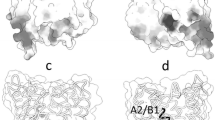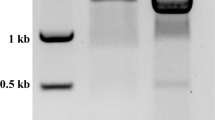Abstract
Glutathione peroxidase (GPx) is a key member of the family of antioxidant enzymes in trematode parasites including Fasciola spp. Because of its abundance and central role as an anti-oxidant that helps to protect parasites from damage by free radicals released from the host immune cells, it has both diagnostic as well as vaccine potential against fasciolosis. In this study, we have cloned, characterized, and detected the expression of the GPx protein in Fasciola gigantica (Fg). FgGPx (582 bp) was cloned by polymerase chain reaction (PCR) from complementary DNA (cDNA) from an adult fluke. Its putative peptide has no signal sequence and is composed of 168 amino acids, with a molecular weight of 19.1 kDa, and conserved sequences at NVACKUG, FPCNQFGGQ, and WNF. Phylogenetic analysis showed that GPx is present from protozoa to mammals and FgGPx was closely related to Fasciola hepatica GPx. A recombinant FgGPx (rFgGPx) was expressed in Escherichia coli BL21 (DE3) and used for immunizing mice to obtain polyclonal antibodies (anti-rFgGPx) for immunoblotting and immunolocalization. In immunoblotting analysis, the FgGPx was expressed in all stages of F. gigantica (eggs, metacercariae, newly excysted juveniles (NEJ), 4-week-old juveniles, and adults). This mouse anti-rFgGPx reacted with the native FgGPx at a molecular weight of 19.1 kDa in adult whole body (WB) and tegumental antigens (TA) as detected by immunoblotting. The FgGPx protein was expressed at a high level in the tegument, vitelline glands, and eggs of the parasite. Anti-rFgGPx exhibited no cross-reactivity with the other parasite antigens, including Eurytrema pancreaticum, Cotylophoron cotylophorum, Fischoederius cobboldi, Gastrothylax crumenifer, Paramphistomum cervi, and Setaria labiato papillosa. The possibility of using rFgGPx for immunodiagnosis and/or as a vaccine for fasciolosis in animals of economic importance will be explored in the future.




Similar content being viewed by others
References
Arthur JR (2000) The glutathione peroxidase. Cell Mol Life Sci 57:1825–1835
Bendtsen JD, Nielsen H, Heijne GV, Brunak S (2004) Improved of signal peptide: SignalP 3.0. J Mol Biol 340:783–795
Blankenberg S, Rupprecht HJ, Bickel C, Torzewski M, Hafner G, Tiret L, Smieja M, Cambien F, Meyer J, Lackne KJ (2003) Glutathione Peroxidase 1 Activity and Cardiovascular Events in Patients with Coronary Artery Disease. N Nngl J Med 349:17
Cai GB, Bae YA, Kim SH, Sohn WM, Lee YS, Jiang MS, Kim TS, Kong Y (2008) Vitellocyte-specific expression of phospholipid hydroperoxide glutathione peroxidases in Clonorchis sinensis. Int J Parasitol 38:1613–1623
Chaithirayanon K, Sobhon P (2010) Molecular cloning and characterization of two genes encoding 2-Cys peroxiredoxins from Fasciola gigantica. Exp Parasitol 125(2):106–113
Changklungmoa N, Chaithirayanon K, Kueakhai P, Meemon K, Sobhon P, Riengrojpitak S (2012) Molecular cloning and characterization of leucine aminopeptidase from Fasciola gigantica. Exp Parasitol 131:283–291
Changklungmoa N, Kueakhai P, Apisawetakan S, Riengrojpitak S, Sobhon P, Chaithirayanon K (2014) Identification and expression of Fasciola gigantica thioredoxin. Parasitol Res 113:2335–2343
Changklungmoa N, Kueakhai P, Sangpairoj K, Chaichanasak P, Jaikua W, Riengrojpitak S, Sobhon P, Chaithirayanon K (2015) Molecular cloning and characterization of Fasciola gigantica thioredoxin-glutathione reductase. Parasitol Res 114:2119–2127
Chantree P, Wanichanon C, Phatsara M, Meemon K, Sobhon P (2012) Characterization and expression of cathepsin B2 in Fasciola gigantica. Exp Parasitol 132:249–256
Chantree P, Phatsara M, Meemon K, Chaichanasak P, Changklungmoa N, Kueakhai P, Lorsuwannarat N, Sangpairoj K, Songkoomkrong S, Wanichanon C, Itagaki T, Sobhon P (2013) Vaccine potential of recombinant cathepsin B against Fasciola gigantica. Exp Parasitol 135:102–109
Gupta A, Pandey T, Kumar B, Tripathi T (2015) Preferential regeneration of thioredoxin from parasitic flatworm Fasciola gigantica using glutathione system. Int J Biol Macromol 81:983–990
Henkle-Dührsen K, Kampkötter A (2001) Antioxidant enzyme families in parasitic nematodes. Mol Biochem Parasitol 114:129–142
Huo R, Yang L, Zhang TG, Wei JY (2017) Human selenium-containing single-chain variable fragment with glutathione peroxidase activity protects NIH3T3 fibroblast against oxidative damage. Mol Biol (Mosk) 51(3):483–489
Imai H, Nakagawa Y (2003) Biological significance of phospholipids hydroperoxide glutathione peroxidase (PHGPx, GPx4) in mammalian cells, free radical. Biol Med 34:145–169
Jaikua W, Kueakhai P, Chaithirayanon K, Tanomrat R, Wongwairot S, Riengrojpitak S, Sobhon P, Changklungmoa N (2016) Cytosolic superoxide dismutase can provide protection against Fasciola gigantica. Acta Trop 162:75–82
Jiang ZH, Mu Y, Li WJ, Yan GL, Luo GM (2002) The progress in mechanism of selenoprotein biosynthesis. Acta Biochem Biophys Sin 34:395–399
Kalita P, Shukla H, Shukla R, Tripathi T (2018) Biochemical and thermodynamic comparison of the selenocysteine containing and non-containing thioredoxin glutathione reductase of Fasciola gigantica. BAA General Subjects 1862:1306–1316
Kim SH, Cai GB, Bae YA, Lee EG, Lee YS, Kong Y (2009) Two novel phospholipid hydroperoxide glutathione peroxidase genes of Paragonimus westermani induced by oxidative stress. Parasitology 136:553–565
Kueakhai P, Meemon K, Changklungmoa N, Chaithirayanon K, Reingrojpitak S, Sobhon P (2011) Characterization and localization of saposin-like protein-2 (SAP-2) in Fasciola gigantica. Parasitol Res 108:1493–1500
Kueakhai P, Changklungmoa N, Chaithirayanon K, Songkoomkrong S, Riengrojpitak S, Sobhon P (2013) Production and characterization of a monoclonal antibody against recombinant saposin-like protein 2 of Fasciola gigantica. Acta Trop 125:157–162
Lee JR, Roh JL, Lee SM, Park Y, Cho KJ, Choi SH, Nam SY, Kim SY (2017) Overexpression of glutathione peroxidase 1 predicts poor prognosis in oral squamous cell carcinoma. J Cancer Res Clin Oncol 143:2257–2265
Lim YS, Cha MK, Kim HK, Uhm TB, Park JW, Kim K, Kim IH (1993) Removals of hydrogen peroxide and hydroxyl radical by thiol-specific antioxidant protein as a possible role in vivo. Biochem Biophys Res Commun 192:273–280
Lowry OH, Rosebrough NJ, Farr AL, Randall RJ (1951) Protein measurement with the Folin phenol reagent. J Biol Chem 193(1):265–275
Mei H, LoVerde PT (1995) Schistosoma mansoni: cloning the gene encoding glutathione peroxidase. Exp Parasitol 80:319–322
Mei H, Thakur A, Schwarts J, LoVerde PT (1996) Expression and characterization of glutathione peroxidase activity in the human blood fluke Schistosoma mansoni. Infect Immun 64:4299–4306
Netto LE, Stadtman ER (1996) The iron-catalyzed oxidation of dithiothreitol is a biphasic process: hydrogen peroxide is involved in the initiation of a free radical chain of reactions. Arch. Biochem Biophys 333:233–242
Roche C, Liu JL, LePresle T, Capron A, Pierce RJ (1996) Tissue localization and stage-specific expression of the phospholipid hydroperoxide glutathione peroxidase of Schistosoma mansoni. Mol Biochem Parasitol 75:187–195
Rotruck JT, Pope AL, Ganther HE, Swanson AB, Hafeman DG, Hoekstra WG (1973) Selenium: biochemical role as a component of glutathione peroxidase. Science 179:588–590
Sangpairoj K, Changklungmoa N, Vanichviriyakit R, Sobhon P, Chaithirayanon K (2014) Analysis of the expression and antioxidant activity of 2-Cys peroxiredoxin protein in Fasciola gigantica. Exp Parasitol 140:24–32
Sansri V, Meemon K, Changklungmoa N, Kueakhai P, Chantree P, Chaichanasak P, Lorsuwannarat N, Itagaki T, Sobhon P (2015) Protection against Fasciola gigantica infection in mice by vaccination with recombinant juvenile-specific cathepsin L. Vaccine 33(13):1596–1601
Sansri V, Changklungmoa N, Chaichanasak P, Sobhon P, Meemon K (2013) Molecular cloning, characterization and functional analysis of a novel juvenile-specific cathepsin L of Fasciola gigantica. Acta Trop 128(1):76–84
Sethadavit M, Meemon K, Jardim A, Spithill TW, Sobhon P (2009) Identification, expression and immunolocalization of cathepsin B3, a stage-specific antigen expressed by juvenile Fasciola gigantica. Acta Trop 112:164–173
Williams DL, Pierce RJ, Cookson E, Capron A (1992) Molecular cloning and sequencing of glutathione peroxidase from Schistosoma mansoni. Mol Biochem Parasitol 52:127–130
Zhang Y, He Y, He L, Zong HY, Cai GB (2015a) Molecular cloning and characterization of a phospholipid hydroperoxide glutathione peroxidase gene from a blood fluke Schistosoma japonicum. Mol Biochem Parasitol 203(1–2):5–13
Zhang Y, He Y, He LI, Zong H, Cai G (2015b) Expression and characterization of a phospholipid hydroperoxide glutathione peroxidase gene in Schistosoma japonicum. Parasitology 142(13):1595–1604
Funding
This research was financially supported by The Thailand Research Fund for New Scholar to Dr. Narin Changklungmoa (Grant no. MRG5980048), a grant from Burapha University as approved by the National Research Council of Thailand to Dr. Narin Changklungmoa (Grant no. 210/2561), a grant from Mahidol University as approved by the National Research Council of Thailand to Associate Professor Dr. Kulathida Chaithirayanon, and a Senior Research Scholar grant from Thailand Research Fund to Professor Dr. Prasert Sobhon.
Author information
Authors and Affiliations
Corresponding author
Ethics declarations
Conflict of interest
The authors declare that they have no conflicts of interest.
Rights and permissions
About this article
Cite this article
Changklungmoa, N., Chaithirayanon, K., Cheukamud, W. et al. Expression and characterization of glutathione peroxidase of the liver fluke, Fasciola gigantica. Parasitol Res 117, 3487–3495 (2018). https://doi.org/10.1007/s00436-018-6046-9
Received:
Accepted:
Published:
Issue Date:
DOI: https://doi.org/10.1007/s00436-018-6046-9




